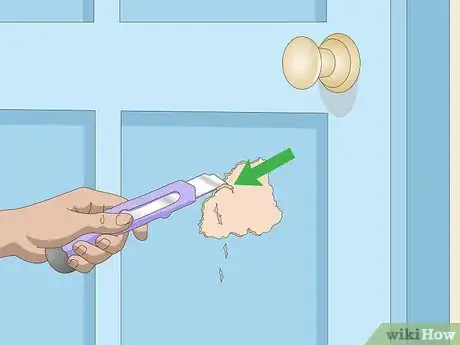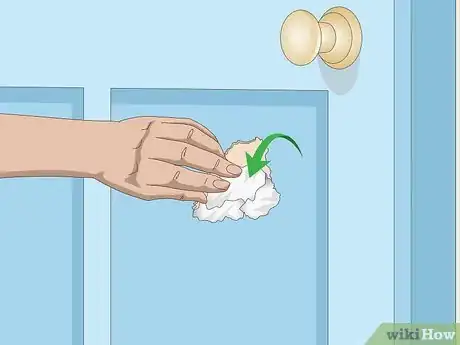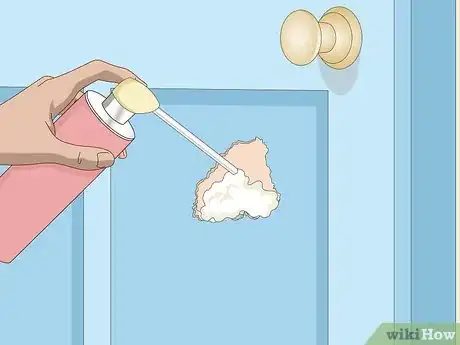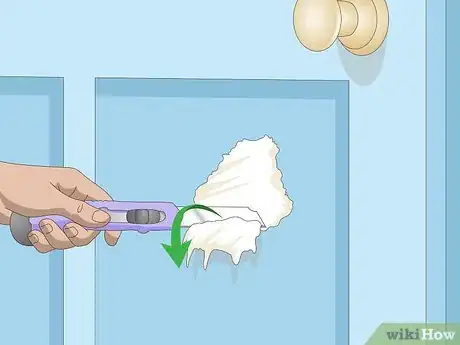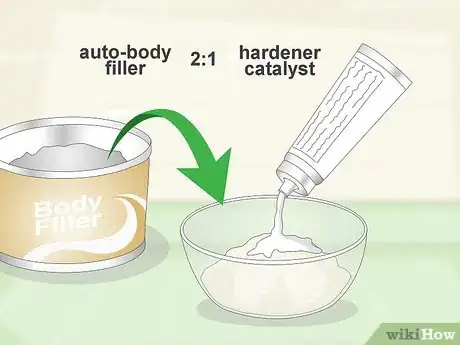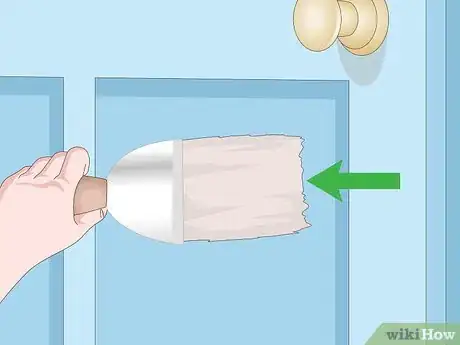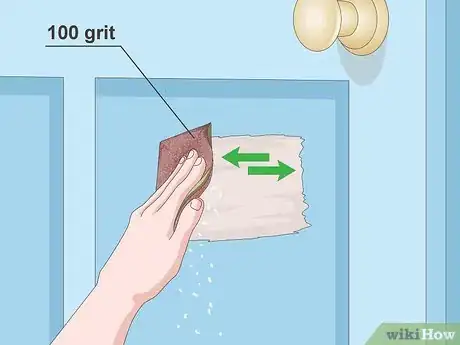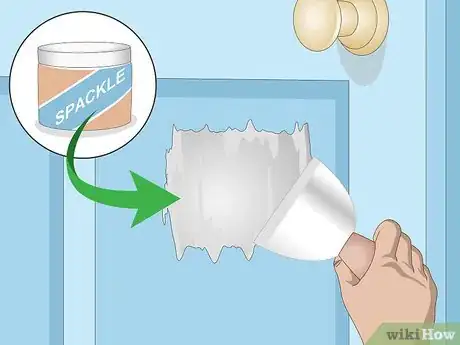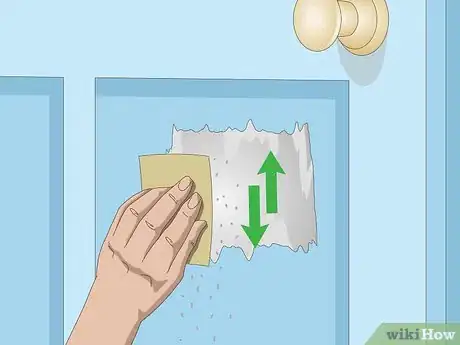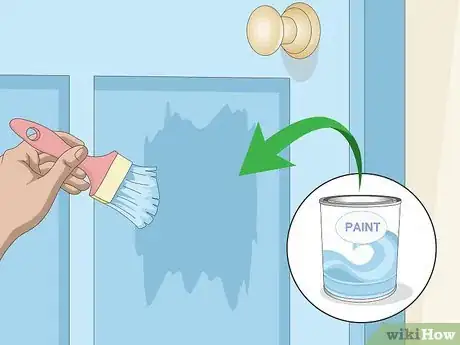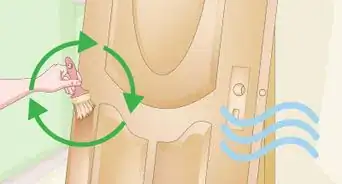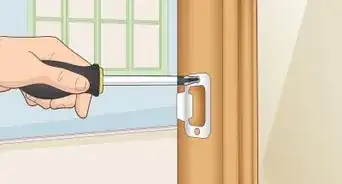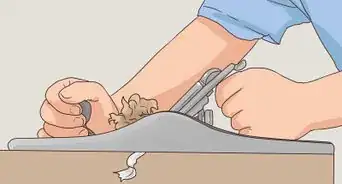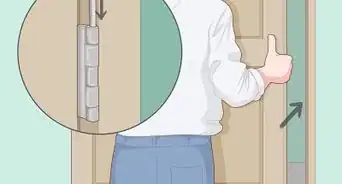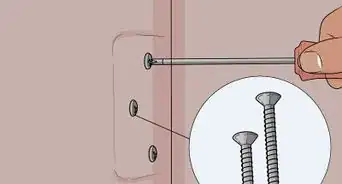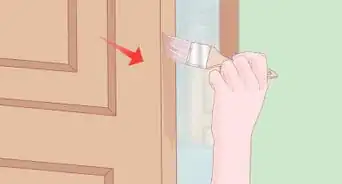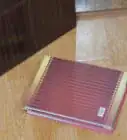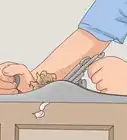This article was co-authored by Barry Zakar. Barry Zakar is a professional handyman and the founder of Little Red Truck Home Services based in the San Francisco Bay Area. With over ten years of experience, Barry specializes in a variety of carpentry projects. He is skilled at constructing decks, railings, fences, gates, and various pieces of furniture. Barry also holds his MBA from John F. Kennedy University.
There are 8 references cited in this article, which can be found at the bottom of the page.
This article has been viewed 43,229 times.
It's pretty easy to accidentally knock a hole in a hollow-core door, but fortunately, it's also pretty easy to fix! We'll show you how you can get your door looking like new again with just a little time and a few materials from the hardware store.
Steps
Trimming and Packing the Hole
-
1Cut any loose plywood away from the edges of the hole. The hole in your door probably has some loose plywood around the ragged edges. Use a utility knife to cut this material away, until you’re left with a clean hole with smooth edges.
-
2Pack a couple of paper towels into the hole. Push in 3 or 4 paper towels, until they’re firmly set in place and won’t slip lower within the door. You’ll need the paper towels in the hole to support the expanding foam you’re about to add. Without the paper towels, the foam would fall to the bottom of the hollow door.
- Paper towels are light enough that they can support their own weight by creating friction against the inner walls of the hollow door.
Advertisement -
3Fill the hole with expanding foam insulation. This material comes in a large aerosol can with a long plastic applicator tip. Squirt a generous amount into the hole, so that the foam expands to fill the hollow space behind the hole. Allow the foam to dry.[1] This will take several hours, so it’s best to let it dry overnight.
- You can purchase foam insulation at any local hardware store or home-supply store. If the store has a variety of options, purchase a low-expansion type. This will leave you with less cleanup.
Applying Auto-Body Resin
-
1Cut the protruding foam. Once your expanding foam has dried, it will have expanded significantly and may extend a couple of inches away from the door. Using your utility knife, cut the excess foam away until the foam is slightly lower than the surface of the door.[2]
- The expanding foam needs to be completely dry before you start trimming. If the center of the foam is still wet, wait a few hours until it’s fully dry.
-
2Mix auto-body filler and a hardener catalyst at a 2:1 ratio. Scoop or squeeze an auto-body filler out of its container and into a disposable bowl or any sort of plastic tray. Then squeeze in half as much hardener catalyst. This material will quickly harden and cover the outside of the door hole. These are both thick, putty-like liquids; use a popsicle stick to stir them until the substances are fully blended.[3]
- Start out with about 1 teaspoon (4.9 ml) of the auto-body filler and half as much catalyst. Mix more as needed.
- Both auto-body filler (such as Bondo) and a hardener catalyst should be available at a large hardware store. If not, check a home-supply store or an auto-body business.
-
3Apply the filler mixture over the dried expanding foam. Use your popsicle stick to scoop up some of the filler mix and smear it over the dried foam that’s filling the hole in your door. This material will dry and harden quickly, so you’ll need to work fast.
- After about 5 minutes, once the filler has started to thicken, take the edge of a putty knife and scrape it across the filler. This will smooth the surface and remove any excess, semi-dry filler.
- Wait to proceed until the filler has fully dried.
-
4Sand the filler with 100-grit sandpaper.[4] Use the sandpaper to sand the fully dried filler until it’s completely smooth and flush with the surface of the door. Also sand off any leftover expanding foam or filler that has stuck to the plywood door material around the edges of the hold you’ve filled.[5]
- Sandpaper of all grit consistencies will be available at your local hardware store.
Spackling and Painting the Hole
-
1Apply spackle over the sanded filler.[6] Use a putty knife to apply a layer of spackle over the hole.[7] Work in long, smooth strokes to apply the putty as smoothly as possible.[8] Allow the spackle to dry once you’ve applied it. Give it about an hour.
- You can find spackle at any hardware or home-supply store.
-
2
-
3Apply a coat of paint over the hole[11] . Now the spackle has dried and been sanded down, you’re ready to finish fixing the hole. Use a large paintbrush to apply a coat of paint over the patched hole.[12] Work in long, smooth strokes so that the layer of paint looks as uniform as possible. Give the paint about an hour to dry, and at that point, the hole will be fixed.
- The paint that you use should match the color of your door. In order to find a good match, visit a paint store, bring home multiple swatches, and find the color closest to that of your door.
Expert Q&A
-
QuestionHow do you repair a hole in a door?
 Kevin TurnerKevin Turner is a handyman and the owner of Red Gator Maintenance, a handyman business based in Fresno, California. Working on handyman-related projects since the age of 12, Kevin specializes in a wide variety of home improvement projects such as (but not limited to) lighting/electrical, plumbing, deck staining, drywall repairs, cabinet installation, air conditioning, trash removal, and window, roof, and appliance repairs.
Kevin TurnerKevin Turner is a handyman and the owner of Red Gator Maintenance, a handyman business based in Fresno, California. Working on handyman-related projects since the age of 12, Kevin specializes in a wide variety of home improvement projects such as (but not limited to) lighting/electrical, plumbing, deck staining, drywall repairs, cabinet installation, air conditioning, trash removal, and window, roof, and appliance repairs.
Commercial Handyman I would recommend filling in the hole with a heavy-duty auto-body filler. Once the filler dries, sand it smooth. Then, add a layer of putty, sand that smooth, and apply primer and paint.
I would recommend filling in the hole with a heavy-duty auto-body filler. Once the filler dries, sand it smooth. Then, add a layer of putty, sand that smooth, and apply primer and paint.
Things You’ll Need
- Utility knife
- Expanding foam insulation
- Polyester resin (auto body filler)
- A hardener catalyst for the filler
- Popsicle stick
- Putty knife
- 100-grit sandpaper
- Spackle
- Paint which matches the color of your door
- Paint brush
Warnings
- Exercise caution when using the utility knife. If you’re not careful, the blade could easily slip and cut your hand. Do not allow young children to play with the knife.⧼thumbs_response⧽
- If the hole is really big, it might be worth replacing the door altogether. Hollow-core doors aren't that expensive, so it's not that big of a burden.[13]⧼thumbs_response⧽
References
- ↑ https://www.youtube.com/watch?v=4K233OoNfKk&feature=youtu.be&t=21s
- ↑ https://www.youtube.com/watch?v=hWuBkO1lpY4&feature=youtu.be&t=4m6s
- ↑ https://www.youtube.com/watch?v=4K233OoNfKk&feature=youtu.be&t=39s
- ↑ Kevin Turner. Commercial Handyman. Expert Interview. 15 July 2020.
- ↑ https://www.youtube.com/watch?v=4K233OoNfKk&feature=youtu.be&t=59s
- ↑ Kevin Turner. Commercial Handyman. Expert Interview. 15 July 2020.
- ↑ Barry Zakar. Handyman. Expert Interview. 16 July 2020.
- ↑ https://www.youtube.com/watch?v=4K233OoNfKk&feature=youtu.be&t=1m5s
- ↑ Barry Zakar. Handyman. Expert Interview. 16 July 2020.
- ↑ https://www.youtube.com/watch?v=4K233OoNfKk&feature=youtu.be&t=1m12s
- ↑ Kevin Turner. Commercial Handyman. Expert Interview. 15 July 2020.
- ↑ Barry Zakar. Handyman. Expert Interview. 16 July 2020.
- ↑ Barry Zakar. Handyman. Expert Interview. 16 July 2020.
About This Article
To fix a hole in a door, start by stuffing a few paper towels in the hole and filling it with expanding foam insulation. Then, once the foam has dried, cut off the excess and apply an auto-body filler mixed with a hardener catalyst over the spot. Next, let the filler dry, and then sand it with 100-grit sandpaper so it's smooth and flush with the rest of the door. Finally, spackle over the filler, sand it down, and apply a coat of paint over it. For tips on how to use auto-body filler, scroll down!
